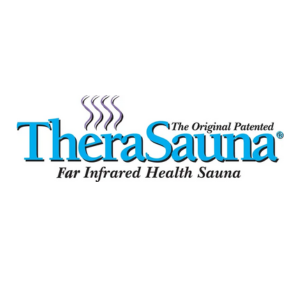ALL ABOUT THE DRY SAUNA EXPERIENCE
If you have recently visited a health club or spa, you might have noticed people excitedly hopping into small, hot rooms and emerging with flushed faces and glistening bodies.
These are not just any heated rooms but dry saunas that leverage intense heat for complete bodily rejuvenation. From boosting detoxification to improving cardiovascular health, dry saunas offer many health benefits that have piqued the interest of wellness communities globally.
How do dry saunas work? What is the best way to use these saunas properly, and where can you find one? Read on to learn everything you need to know about this ancient and popular wellness practice.
Dry Saunas: What Are They and How Do They Work?
Dry saunas (like the Almost Heaven Salem) are typically small rooms with walls, ceilings, and benches constructed from softwoods like white fir, cedar, thermally modified hemlock, or Nordic spruce. Such wood types soak up excess moisture and heat without overheating — essentially working like a natural insulator, ensuring the perfect temperament for your wellness ritual.
A dry sauna's heat source can be a wood-burning stove or an electric heater. While wood-burning stoves add a touch of authenticity and often contribute to a subtle, smoky aroma, electric heaters offer convenience and ease of use. They heat up quickly and precisely, giving you more control over the room's temperature.
Besides the heat source, a significant part of the set-up is a pile of rocks, often made from igneous stones, placed on or around the heat source. These stones are generally chosen for their high heat retention properties.
When heated by the stove or electric heater, these stones absorb and store the heat. This stored heat is then released gradually, which helps radiate warmth throughout the room.
The typical temperature in a dry sauna ranges from 158 to 212 degrees Fahrenheit, and the humidity level is relatively low, typically less than 20%. This delicate balance of warmth and low humidity is what sets a dry sauna apart from a steam sauna, which can make you feel damp and sweaty.
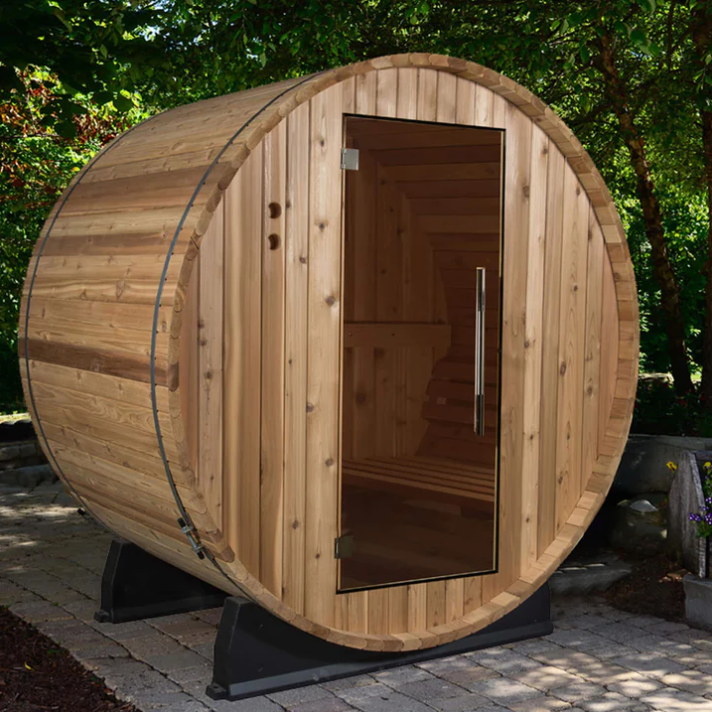
How Dry Saunas Differ from Other Types of Saunas
Dry Sauna vs. Steam Rooms
Dry and wet saunas are both designed to make you sweat, but they use different methods to achieve this goal.
Here's how they differ:
Temperature and Humidity
The dry sauna experience is all about the heat. They can get pretty toasty, generally staying between 170 and 195 degrees Fahrenheit and maintaining a humidity level of around 10-20%. This delivers a hot but dry atmosphere.
Steam rooms, as the name suggests, use steam generators to fill the room with moist, warm air that helps you get your sweat on. The temperature range in a steam room is a bit cooler, at around 110 to 120 degrees Fahrenheit, but the humidity level is at a whopping 100%.
Construction Material
Dry saunas are typically constructed with wood, which absorbs the humidity and keeps the atmosphere dry. On the other hand, steam rooms are often lined with tile or plastic to prevent moisture damage.
Health Benefits
While dry saunas and steam rooms are both incredibly beneficial for muscle relaxation, improving circulation, and skin cleansing, steam rooms are particularly effective at relieving symptoms of congestion or other respiratory ailments — thanks to the higher humidity level.
Dry Sauna vs. Infrared Sauna
While dry and infrared saunas (like the Dynamic Saunas) are both designed to help you relax and detoxify your body, the way they operate is where the real difference lies.
Heat source
Dry saunas use a stove or an electric heater to produce heat. Infrared saunas use a highly specialized heating element that produces infrared light waves.
These waves penetrate deep into your body, heating you from the inside out. The result is a more powerful detoxification effect than a dry sauna alone.
Temperature Settings
Dry saunas operate at high temperatures, often between 150 to 195 degrees Fahrenheit.
Conversely, infrared saunas operate at a much lower, cozier temperature, usually somewhere between 110 to 135 degrees Fahrenheit. This helps create a more comfortable, gentle environment while coaxing toxins out of your body.
Health Benefits
Dry saunas, including Korean dry saunas, can be a lifesaver for individuals suffering from chronic pain, stress, anxiety, and even depression. Research shows that regular sauna workouts can improve heart health by increasing blood flow and reducing blood pressure. Since the dry heat draws oxygen to your skin's surface, studies show that it can also help improve your skin texture.
Like their dry counterparts, infrared saunas also stimulate blood circulation, easing muscle tension and aiding in recovery. What makes them stand out is their ability to alleviate chronic pain. Whether it's nagging backaches or persistent joint pain, infrared heat can penetrate deeper into tissues, offering much-needed relief.

Benefits of Using a Dry Sauna
Dry saunas offer several health benefits, including:
Improved Cardiovascular Health
Dry saunas expose you to high temperatures, making your heart beat faster and pumping more blood. According to UCLA Health, this increased cardiovascular activity can help strengthen your heart muscles, improve circulation, reduce blood pressure, and much more.
A 2015 study published in the Journal of the American Medical Association (JAMA) demonstrated that regular sauna users had lower heart disease and stroke death rates, potentially adding years to your life.
Reduced Stress
While some stress keeps us alert and ready for action, too much can cause mental health troubles, cardiovascular conditions, irregular periods, and gastronomical issues (via WebMD).
If traditional stress management techniques haven't worked for you, or you're seeking an alternative method to add to your routine, a dry sauna could be a lifesaver.
As you steep in the intense heat of a sauna, your body temperature increases. Research shows that this controlled increase in body temperature causes your cortisol levels to drop, alleviating the symptoms of stress and anxiety.
Studies explain that the high heat also triggers the release of endorphins, aka "feel-good" hormones. These neurochemicals create a sense of euphoria and help combat pain, similarly to how painkillers work. Cleveland Clinic notes that this rush of endorphins can help neutralize stress's effects and promote happiness.
Relieved Pain
When you're suffering from sore muscles after an intense workout or dealing with a stubborn neck sprain, dry saunas can help. The Arthritis Foundation notes that as your body heats, your blood vessels expand. This allows for more oxygen and nutrient delivery to injured tissues, speeding up healing.
Beaumont Health further explains that this vasodilation process also accelerates the removal of metabolic waste—a key factor contributing to post-injury or post-workout pain. This can especially benefit people with fibromyalgia, arthritis, or stiff joints.
Better Skin Health
It's no secret that sauna use can help you get glowing, healthy skin. The soothing warm heat helps unclog your pores and increases blood flow to the outer layers of your epidermis.
Research shows that this enables more oxygen and water to reach deeper layers of your skin increasing cell turnover and resulting in smoother skin.
The best part? Post sauna, your skin absorbs serums, moisturizers, and other skincare products more effectively, so you get the added benefit of better hydration and improved skin texture.
Boosted Immune System
Beyond relaxation and stress relief, dry saunas remarkably affect your immune system. A 2013 study found that sauna bathing significantly boosted the immune system of athletes.
Your body produces heat shock protein as your core temperature increases within the sauna. Research shows that these proteins can help protect you from cellular damage, which can potentially ward off infections.

Dry Sauna Safety and Precautions
Dry saunas can also negatively affect your health if you use them improperly or excessively. Here are some of the risks and precautions that you should consider before you enter a dry sauna:
-
Dehydration: Dry sauna can cause you to lose a lot of water and electrolytes through sweating. This can lead to dehydration, which can cause headaches, dizziness, nausea, fatigue, and cramps. To help avoid this, drink plenty of water before, during, and after your sauna session. You should also avoid alcohol, caffeine, and other diuretics that can dehydrate you further.
-
Overheating: Dry sauna can raise your body temperature to dangerous levels if you stay in too long or the room is too hot. This can lead to heat exhaustion or heat stroke, which can cause confusion or fainting. Limit your sauna session to 15 to 20 minutes or less, depending on your tolerance level. You should also monitor how you feel and leave the sauna if you feel unwell or uncomfortable.
-
Alcohol consumption: Dry sauna can increase the effects of alcohol on your body and brain, impairing your judgment, coordination, and reaction time. It can also increase your risk of dehydration, overheating, and low blood pressure. Consider avoiding alcohol before or during your sauna session. You should also wait at least an hour after your sauna session before drinking alcohol.
Tips for the Perfect Sweat Session
Dry saunas can be a wonderful experience if you follow some simple tips and guidelines. Here are some of them:
-
Wear the right clothes: Opt for loose and comfortable clothing or a towel when you use a dry sauna. Make sure you remove any jewelry, glasses, contact lenses, or other accessories that can heat up or irritate your skin. You should also consider bringing a towel to sit on and another one to wipe your sweat.
-
Prepare yourself: You should shower before entering a dry sauna to remove any dirt, oil, or cosmetics from your skin. This will help you sweat more easily and prevent any potential infections or irritations. Ensure you load up on water before your sauna session to prevent dehydration.
-
Enjoy yourself: Make sure to relax and simply enjoy your time in the dry sauna. You can listen to music, read a book, meditate, or chat with your friends. Breathing deeply can help oxygenate your blood and calm your mind.
-
Cool down gradually: Consider leaving the dry sauna when you feel hot enough or when your time is up. You should not stay longer than 20 minutes or more than once a day. Try to cool down gradually by taking a shower, drinking water, or resting in a cool area. This will help you avoid sudden changes in your body temperature and blood pressure.
Dry Sauna Experience: FAQs
How Long Should You Sit in a Dry Sauna?
How long you should sit in a dry sauna depends on your preference and needs. Ideally, you should start with shorter sessions in a dry sauna, around 5 to 10 minutes, and work your way up from there. Ensure not to exceed 20 minutes in a dry sauna without taking a break to avoid excessive dehydration or hyperthermia.
Is a Dry Sauna Really Good for You?
Absolutely! Research suggests regular dry sauna sessions can help improve cardiovascular health, ease muscle pain, increase metabolic rate, and even reduce stress.
Is It Okay To Use a Dry Sauna Every Day?
Yes, using a dry sauna daily is safe if you take proper precautions and don't extend your session beyond 20 minutes. If you take any medications or have any medical conditions, such as heart disease, high blood pressure, or diabetes, consult your healthcare provider before planning a sweat session.
What Should I Do Before a Dry Sauna?
You can do a couple of things before a dry sauna to maximize your experience. For starters, make sure you're well-hydrated. Water, herbal tea, or refreshing coconut water are all good options.
You can also eat some light snacks to keep your energy levels up, but avoid anything too heavy or fatty, to avoid any potential nausea.
Always remove your jewelry and wristwatch, as the heat or sweat can potentially damage them. You may also want to take off your shoes and wear flip-flops or sandals because the floor can get very hot and slippery. If you sit on a bench or chair in the sauna, consider bringing a towel to sit or lay on.
Do I Have To Shower Before a Dry Sauna?
While you aren’t required to shower beforehand, it's generally a good idea. Showering before a dry sauna session can help remove sweat, oils, and residual makeup from your skin, so you can sweat freely without potentially clogging your pores.
Do You Wear Clothes in a Dry Sauna?
Wearing clothes in a dry sauna is a matter of personal preference and cultural norms. While most people use the sauna nude or with a towel wrapped around them, others may feel uncomfortable being naked in front of others.
If you choose to cover yourself, opt for loose-fitting breathable garments made of cotton or linen. Avoid wearing synthetic fabrics like nylon or polyester, as they stick to your skin and cause irritation.
Some saunas may have specific dress codes or policies to follow. Always check with the staff or the sauna website before you go, and respect the norms of other users.

That's a Wrap on Dry Saunas!
With its soothing warmth and calming ambiance, dry saunas can do wonders to ease muscle tension, improve blood circulation, and enhance your immune system.
To make the most of your dry sauna experience, ensure you stay hydrated, limit your time, wear appropriate clothing, and consult your doctor before using a sauna if you have any medical conditions.
If you want to enjoy the benefits of a dry sauna from the comfort of your home, check out MySaunaWorld's impressive collection of traditional and infrared saunas. For more information on our models or any queries, feel free to contact us, and our friendly staff will be happy to assist.
SIGN UP. SAVE BIG.
Subscribe to be the first to know about our special monthly sauna sales, sent right to your inbox.

About the Author
Adam Fromson
Adam Fromson, co-founder of My Sauna World, loves saunas and their transformative health benefits. With years of experience exploring sauna culture and its impact on health and wellness, Adam is passionate about helping others discover the life-changing benefits of saunas for themselves.
Let customers speak for us
from 385 reviews
Good communication, easy delivery, easy set up, easy operation, great value. Recommended!
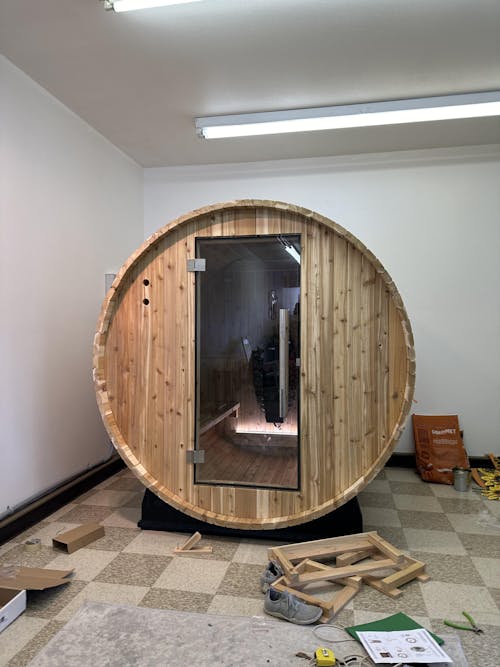
We ordered the 4 person barrel sauna and love it! We wanted a little extra space for the 2 of us/guests and it’s great. We could definitely fit 4 people in it if we needed. We use it every single day. It took about 10 weeks to get here because they build it specifically for the order. Putting the barrel together was fairly easy with 2 people. The electrical and the heater definitely required an electrician to install as we could have not done it alone.
We ordered the biggest heater (harvia spirit 8kw) and it heats up the sauna in about 15 mins inside our 40-50° garage. Overall this style of sauna is hotter and you sweat a lot faster than in an infrared sauna. I truly 10/10 recommend!
Pic is of us in the middle of building it.
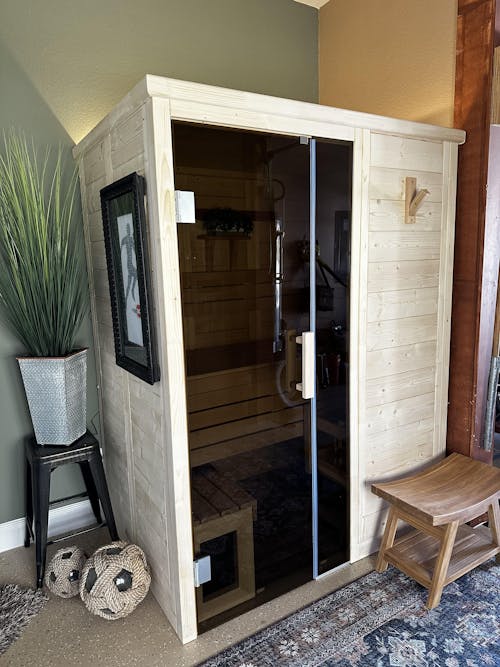
Took me about 6 hours over 2 evenings to assemble almost all by myself. Had a pro run a new circuit from my panel. Very well made and assembly was straightforward. Heater is well sized and reaches operating temperature in under 30 minutes.

Great sauna very easy to assemble

The salt panel was a great addition to our Madison Sauna. It has excellent grain which is accented by the amazing color lights that glow through the panel. Also when you hit the rocks with a splash of water you can feel the heat bounce off the panel. Great addition if you are considering this option.
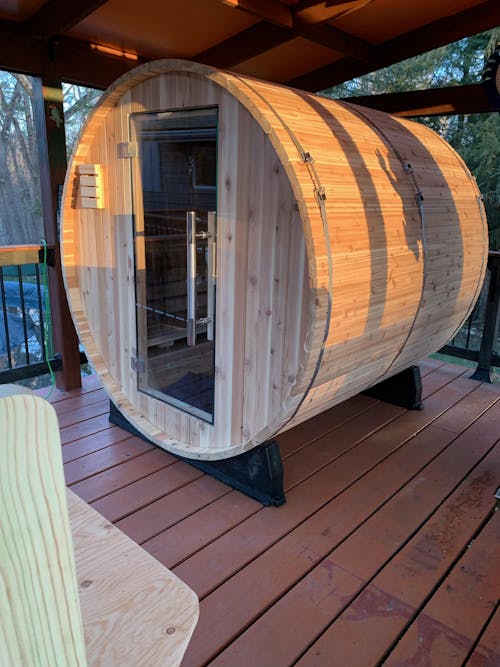
We can say enough about Sauna World there customer support is great! Our Pinnacle Sauna from Almost Heaven is epic.
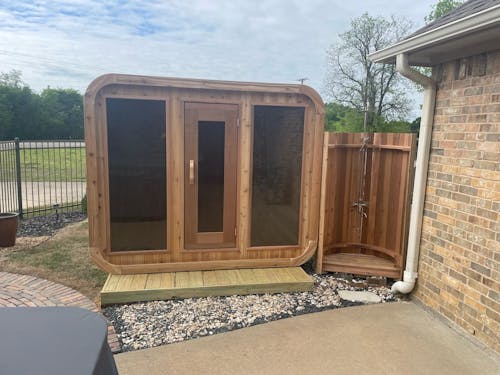
The finish and quality is outstanding and it was quick and easy to assemble.

We are thrilled with our mini pod!! It came well shipped and our friend assembled it in 11 hours! Wow! We cannot wait to get healthy and sauna it up!

Beautiful sauna!!! Much easier than I expected to assemble, took a total of 4 hours. Can't wait to get warm by the pool on those cool evenings. Customer service was excellent..

Purchased a 2 person Almost Heaven barrel sauna and were delighted with the product. The order process was quick and easy, the sauna arrived on-time, installation was simple, following the provided instructions, and the sauna is extremely high quality. We’ve used it daily for over 2 weeks and quite frankly I don’t know how we lived without it. If I had it to do over again I wouldn’t change a thing... except maybe purchasing a 4 person model to easier share with friends!

Great Customer Service and a breeze to put together.Excellent shipping and the Sauna is top notch, couldn’t be happier




























